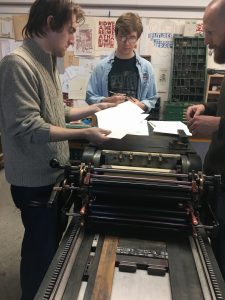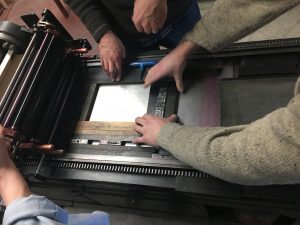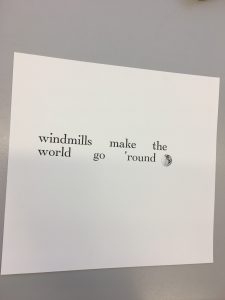The printing press workshop workshop was fun for many reasons. I enjoyed looking at the various printed images and words on the walls and feeling almost as if I had traveled back in time. I liked learning about the machine (which looks highly complex, but turns out to be pretty user friendly) and understanding the steps it takes to get a print to turn out clean. From inking the cylinder to clipping in the paper at the right point to checking to see if all the letters are in the right place, I was able to appreciate the thoughtfulness required for a successful printmaking process. Playing with the different fonts, and devising potential images and spacing to go along with my group’s selected quote was creatively stimulating and I would have loved to spend more time thinking of quotes and matching them with available images. Being able to see and use a real printing press is something I never would have thought I’d be able to experience.
The pictures below show our printmaking process and how preparing the print is not as easy as one might think. Will and I kept getting confused as to whether or not our print would read the right way, and it turns out we had initially written our quote the wrong way from right to left, instead of left to right. After fixing that we thought we were good to go, but our first print revealed that we mixed up our ‘b’ and ‘d’ lettering in the word “windmill” and “round”. The mistakes made in the printmaking process add character to the paper and don’t always have to be viewed as mistakes that need to be thrown away. There is value in the learning process, and I am grateful I had the opportunity to learn about old-fashioned printmaking in an era of digital and automatic printing, so that I could appreciate mechanics behind making a print. 




I love the backwards print! Such an easy mistake to make, I’m sure all of us came pretty close– besides, hang them next to each other and it’ll look practically intentional. I’m glad you brought up the fact that as many moving parts as the press has, it’s actually pretty straightforward to operate. It’s easy to imagine printing hundreds of copies without any trouble. The learning curve would come in setting the type for, say, a Bible or a newspaper.
One of our initial ideas was to print our quote in red ink and then overlay the text in black ink. Unfortunately, we were not able to accomplish that because lining up the text in class today in the same spot that it was in on Monday proved to be too challenging! Instead of having the text aligned, the text in black ink printed about half of an inch to the right of the original text in red. Preparing for the prints is a lot more challenging than I originally thought!